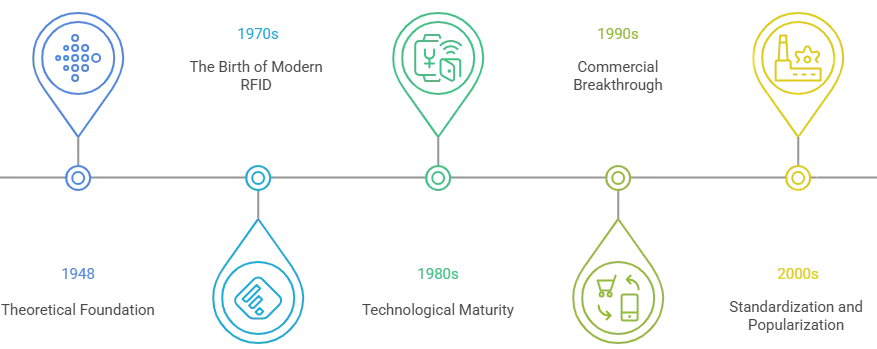
From WWII to Smart Cities: The Evolution of RFID Technology
Custom Your RFID Cards
RFID technology has become an indispensable part of many fields. It is widely used in logistics management, identity recognition, the Internet of Things, and other areas, greatly improving efficiency and security. Now, we will trace the historical development of RFID, analyze its technological evolution, and explore future development directions.
The Early Origins of RFID
19th Century: The Foundations of Electromagnetic Theory
In the 1830s, Michael Faraday demonstrated through electromagnetic induction experiments that radio waves could transmit energy. This discovery laid the theoretical foundation for subsequent wireless communication technologies.
In 1935, Sir Robert Alexander Watson-Watt invented radar, further advancing wireless technology. The emergence of radar technology provided the technical foundation for early RFID applications.
Early Wireless Communication Experiments
Besides Faraday and Watson-Watt’s contributions, early wireless communication experiments also laid the technical backdrop for RFID development. For example, Guglielmo Marconi conducted wireless signal transmission experiments in the late 19th century achieved long-distance communication. These experiments demonstrated the potential of radio waves for information transmission, laying the groundwork for subsequent RFID technology development.
During World War II: Identification Friend or Foe (IFF)
During WWII, radar was used to ID enemy and friendly planes. The RAF achieved basic ID by changing radar signal reflections through aircraft rolls. In 1945, Leon Theremin invented the “Thing” for the Soviet Union. This passive device used external radio waves for power and could transmit signals. Though initially for spying, it was similar to later RFID tech and is seen as an early precursor.
Early patents and concepts
From the late 19th century to the early 20th century, some early patents and concepts already touched on technologies similar to RFID. Although these patents and concepts did not directly evolve into modern RFID technology, they provided important inspiration for later researchers. For example, some early wireless communication patents involved the basic principles of signal transmission and reception, which were widely applied in later RFID technology.
Modern Development of RFID

1948: Theoretical Foundation
After World War II, Harry Stockman published an article titled “Communication by Reflected Power.” The article predicted future application scenarios for RFID but also pointed out that there were still many technical challenges to overcome before these applications could be realized, thereby guiding future research efforts.
1970s: The Birth of Modern RFID
In 1971, Mario Cardullo demonstrated the first passive radio frequency responder to the Port Authority of New York. This responder had 16 bits of memory and could be used for toll collection devices. On January 23, 1973, Cardullo was granted a patent (US 3713148), which included content related to using radio frequency, sound, and light as transmission carriers.
In 1973, Steven Depp, Alfred Koelle, and Robert Freyman from Los Alamos National Laboratory demonstrated an RFID tag based on reflected power, operating at 915 MHz with 12 bits of memory. This achievement laid the foundation for the development of modern UHF and microwave RFID.
1980s: Technological Maturity
In 1983, Charles Walton obtained the first patent using the term “RFID” (US 4,384,288), which played a significant role in the naming and standardization of the technology.
In the late 1980s, RFID began to be applied in real-world scenarios, such as California’s FasTrak toll system and some access control systems, improving management efficiency. During this period, the United States led in technological research and development, while Europe also began to focus on and invest in RFID technology research, creating a competitive landscape.
1990s: Commercial Breakthrough
In 1996, David Everett and others obtained the first patent for a battery-free, low-interference passive RFID tag (US 5,491,468), lowering the barriers to application.
In 1998, Malaysia issued the first RFID-enabled passport, marking the beginning of RFID’s application in identity verification. During this phase, businesses and research institutions from different countries engaged in both competition and technical exchanges, driving technological progress.
2000s: Standardization and Popularization
In 2004, EPCglobal approved the Gen 2 standard (ISO 18000-6C), unifying UHF RFID protocols. The United States and Europe actively participated in the standardization process, collaborating to drive the development of standards.
In 2006, the cost of RFID tags dropped to 5 cents, a price advantage that led to widespread adoption in retail and supply chain sectors, further driving the popularization of RFID.
RFID Technology Evolution
Core Component Development
Tags have evolved from passive to active and semi-passive. Passive tags are powered by readers, offering low cost but limited read range; active tags have built-in batteries, enabling longer read ranges but at higher cost; semi-passive tags combine the advantages of both. Tag sizes continue to shrink, with “dust tags” now suitable for precision applications.
Readers have evolved from single-frequency to multi-frequency support, enabling compatibility with a wider range of tags. They are also moving toward mobility, with smartphones integrated with NFC capable of functioning as simple readers.
Antennas have transitioned from rigid to flexible designs to adapt to more diverse object surfaces. Printed electronics technologies, such as inkjet-printed antennas, reduce costs while enhancing design flexibility.
Frequency and Standards
Low-frequency (125 kHz) has strong penetration and is used for access control and animal identification; high-frequency (13.56 MHz) has higher data rates and is suitable for books and smart cards, adhering to the ISO/IEC 14443 standard; ultra-high-frequency (860–960 MHz) offers fast transmission and long-range identification, making it ideal for supply chain applications, following the EPC Gen2 standard, with the RAIN RFID Alliance driving its development.
Integration with Other Technologies
- Combined with sensors to form temperature and humidity sensing RFID, used in environmentally sensitive fields such as food and pharmaceuticals.
- Integrated with blockchain to achieve anti-counterfeiting and traceability, with information that is traceable and tamper-proof.
- Combined with AI to analyze data, optimize supply chain inventory, predict demand, and improve efficiency.
Key Figures and Contributions
| Person | Year | Contribution |
| Michael Faraday | 1830s | Developed electromagnetic induction theory, providing the foundation for RFID |
| Sir Robert Alexander Watson-Watt | 1935 | Invented radar, advancing identification friend or foe (IFF) systems |
| Leon Theremin | 1945 | Invented “The Thing,” a passive listening device, an early precursor to RFID |
| Harry Stockman | 1948 | Published “Communication by Means of Reflected Power,” predicting RFID uses |
| Mario Cardullo | 1971-1973 | Demonstrated the first passive RFID transponder and received a patent, covering multiple transmission carriers |
| Charles Walton | 1983 | Received the first patent using the term “RFID,” advancing its naming |
Expansion of Application Areas
Classic Applications
In the supply chain and logistics sector, RFID plays a crucial role. It enables efficient inventory management, providing real-time tracking of goods quantities and locations. For instance, Amazon warehouses utilize RFID to swiftly complete inventory counts and logistics coordination. Additionally, in goods tracking, RFID allows for comprehensive monitoring of transportation status throughout the entire process, thereby enhancing logistics efficiency.
The retail industry also widely adopts RFID. Amazon Go’s unmanned stores utilize RFID for automatic product identification and checkout, making shopping more convenient; EAS systems combined with RFID technology effectively prevent product theft and reduce retail losses.
Emerging Scenarios
In healthcare, RFID tracks surgical instruments, ensuring clear records of sterilization and usage to reduce medical errors. It also identifies patients quickly and accurately, enhancing medical safety.
In smart city development, RFID supports waste sorting by embedding tags in bins or labels for waste traceability and statistics. In intelligent transportation, RFID identifies vehicles to improve toll station efficiency and manage parking lots.
In agriculture, the EU uses RFID for livestock tracking to aid disease prevention and traceability. RFID also records the entire process of agricultural products from planting to sales, allowing consumers to access product information.
Consumer-level applications
NFC payments, like Apple Pay leverage RFID technology to enable contactless payments via smartphones or other devices, eliminating the need for physical cards and offering convenience and security. In smart homes, RFID door locks allow users to unlock doors effortlessly via tags or smartphones, enhancing living convenience.
Future Trends
Technological Innovation Trends
RFID will keep blending with IoT, big data, and AI. With IoT, it can connect more devices. Big data analysis can find valuable patterns from RFID info. AI can make RFID systems smarter in handling data and tricky situations. Future progress might happen in tag performance, read range, and interference resistance.
Market Trends
The RFID market is growing. It will hit $16.73 billion by 2025 and $29.06 billion by 2030 (source). As tech improves and costs drop, RFID will be used more in logistics, retail, healthcare, and farming.
- Opportunities are in:
- New areas: RFID in industrial internet and smart aging care.
- Existing areas: More use in logistics, retail, and healthcare.
- By region:
- North America: Biggest market in 2024.
- Asia-Pacific: Fastest growth.
- Europe: Strong market for retail and fashion.
Social Impact
RFID use raises privacy and security concerns, like personal info leaks. Future policies will better regulate RFID to balance tech growth and privacy. More focus on RFID security will boost encryption tech.
Summary
RFID tech, first made for the military, now impacts daily life in many ways. It went from identifying enemies in WWII to being used in logistics, retail, healthcare, and more. As a key part of the “Internet of Everything,” RFID has big potential. With more innovation and wider use, it will keep connecting things and boosting efficiency.


